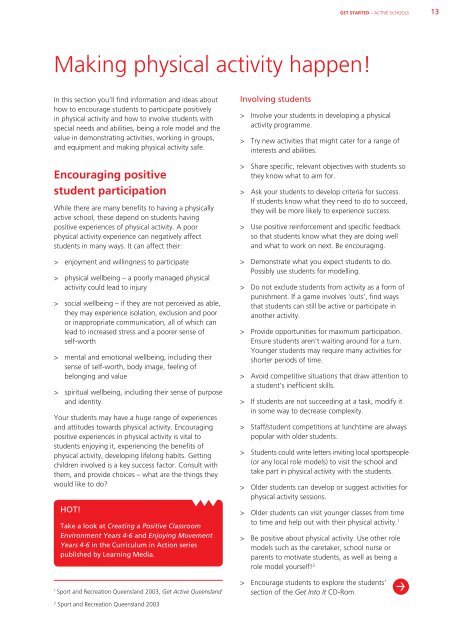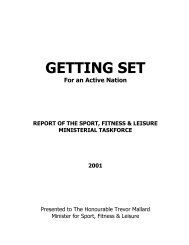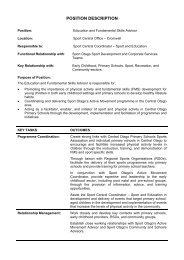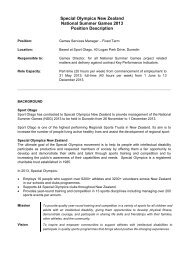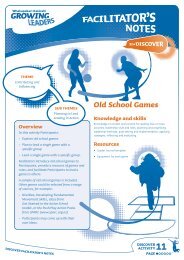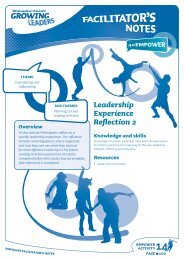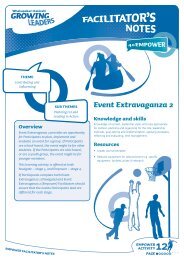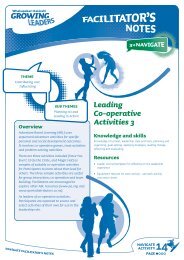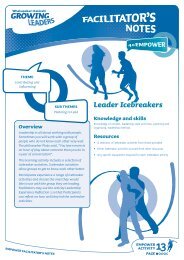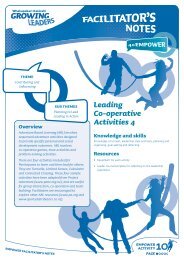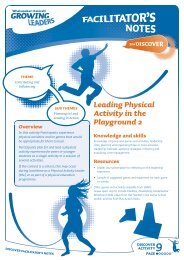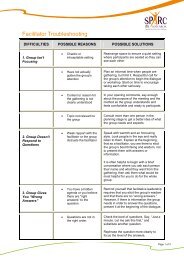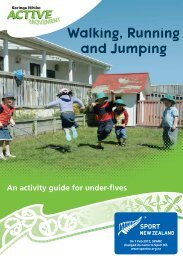Download Get Started (one document) - Sport New Zealand
Download Get Started (one document) - Sport New Zealand
Download Get Started (one document) - Sport New Zealand
Create successful ePaper yourself
Turn your PDF publications into a flip-book with our unique Google optimized e-Paper software.
GET STARTED – ACTIVE SCHOOLS 13<br />
Making physical activity happen!<br />
In this section you’ll find information and ideas about<br />
how to encourage students to participate positively<br />
in physical activity and how to involve students with<br />
special needs and abilities, being a role model and the<br />
value in demonstrating activities, working in groups,<br />
and equipment and making physical activity safe.<br />
Encouraging positive<br />
student participation<br />
While there are many benefits to having a physically<br />
active school, these depend on students having<br />
positive experiences of physical activity. A poor<br />
physical activity experience can negatively affect<br />
students in many ways. It can affect their:<br />
> enjoyment and willingness to participate<br />
> physical wellbeing – a poorly managed physical<br />
activity could lead to injury<br />
> social wellbeing – if they are not perceived as able,<br />
they may experience isolation, exclusion and poor<br />
or inappropriate communication, all of which can<br />
lead to increased stress and a poorer sense of<br />
self-worth<br />
> mental and emotional wellbeing, including their<br />
sense of self-worth, body image, feeling of<br />
belonging and value<br />
> spiritual wellbeing, including their sense of purpose<br />
and identity.<br />
Your students may have a huge range of experiences<br />
and attitudes towards physical activity. Encouraging<br />
positive experiences in physical activity is vital to<br />
students enjoying it, experiencing the benefits of<br />
physical activity, developing lifelong habits. <strong>Get</strong>ting<br />
children involved is a key success factor. Consult with<br />
them, and provide choices – what are the things they<br />
would like to do?<br />
HOT!<br />
Take a look at Creating a Positive Classroom<br />
Environment Years 4-6 and Enjoying Movement<br />
Years 4-6 in the Curriculum in Action series<br />
published by Learning Media.<br />
1<br />
<strong>Sport</strong> and Recreation Queensland 2003, <strong>Get</strong> Active Queensland<br />
Involving students<br />
> Involve your students in developing a physical<br />
activity programme.<br />
> Try new activities that might cater for a range of<br />
interests and abilities.<br />
> Share specific, relevant objectives with students so<br />
they know what to aim for.<br />
> Ask your students to develop criteria for success.<br />
If students know what they need to do to succeed,<br />
they will be more likely to experience success.<br />
> Use positive reinforcement and specific feedback<br />
so that students know what they are doing well<br />
and what to work on next. Be encouraging.<br />
> Demonstrate what you expect students to do.<br />
Possibly use students for modelling.<br />
> Do not exclude students from activity as a form of<br />
punishment. If a game involves ‘outs’, find ways<br />
that students can still be active or participate in<br />
another activity.<br />
> Provide opportunities for maximum participation.<br />
Ensure students aren’t waiting around for a turn.<br />
Younger students may require many activities for<br />
shorter periods of time.<br />
> Avoid competitive situations that draw attention to<br />
a student’s inefficient skills.<br />
> If students are not succeeding at a task, modify it<br />
in some way to decrease complexity.<br />
> Staff/student competitions at lunchtime are always<br />
popular with older students.<br />
> Students could write letters inviting local sportspeople<br />
(or any local role models) to visit the school and<br />
take part in physical activity with the students.<br />
> Older students can develop or suggest activities for<br />
physical activity sessions.<br />
> Older students can visit younger classes from time<br />
to time and help out with their physical activity. 1<br />
> Be positive about physical activity. Use other role<br />
models such as the caretaker, school nurse or<br />
parents to motivate students, as well as being a<br />
role model yourself! 2<br />
> Encourage students to explore the students’<br />
section of the <strong>Get</strong> Into It CD-Rom.<br />
2<br />
<strong>Sport</strong> and Recreation Queensland 2003


